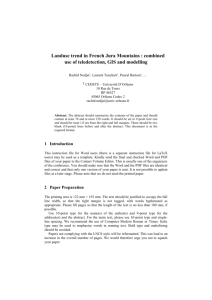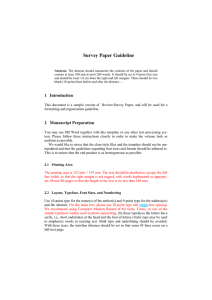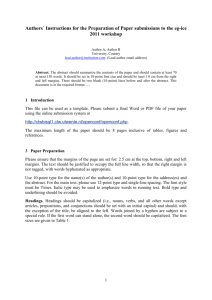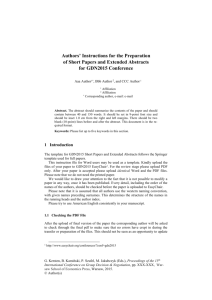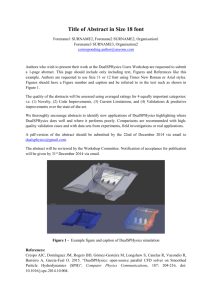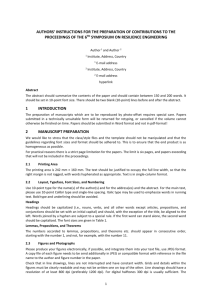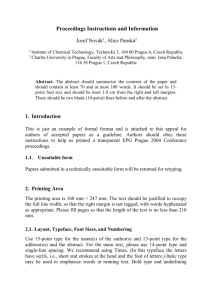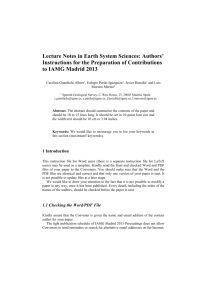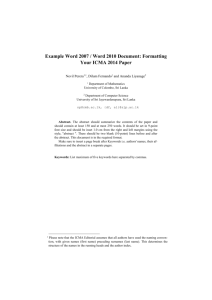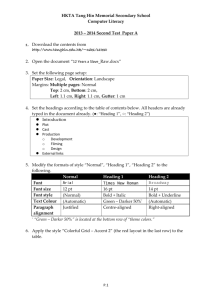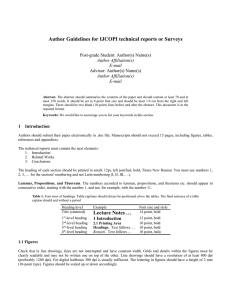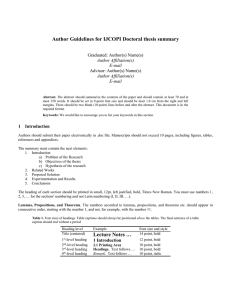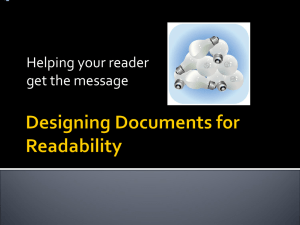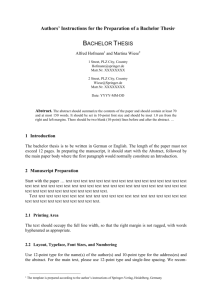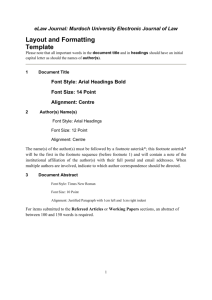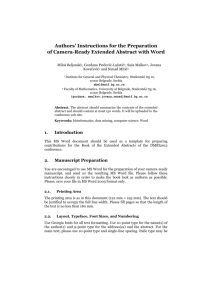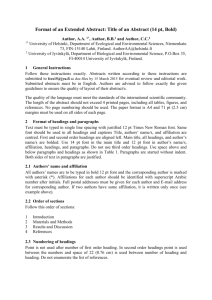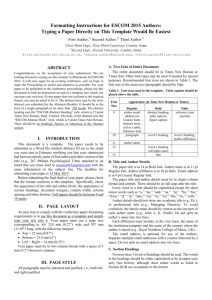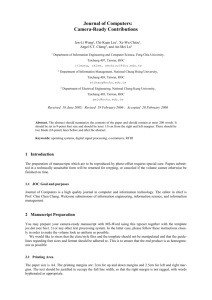Lecture Notes in Computer Science:
advertisement
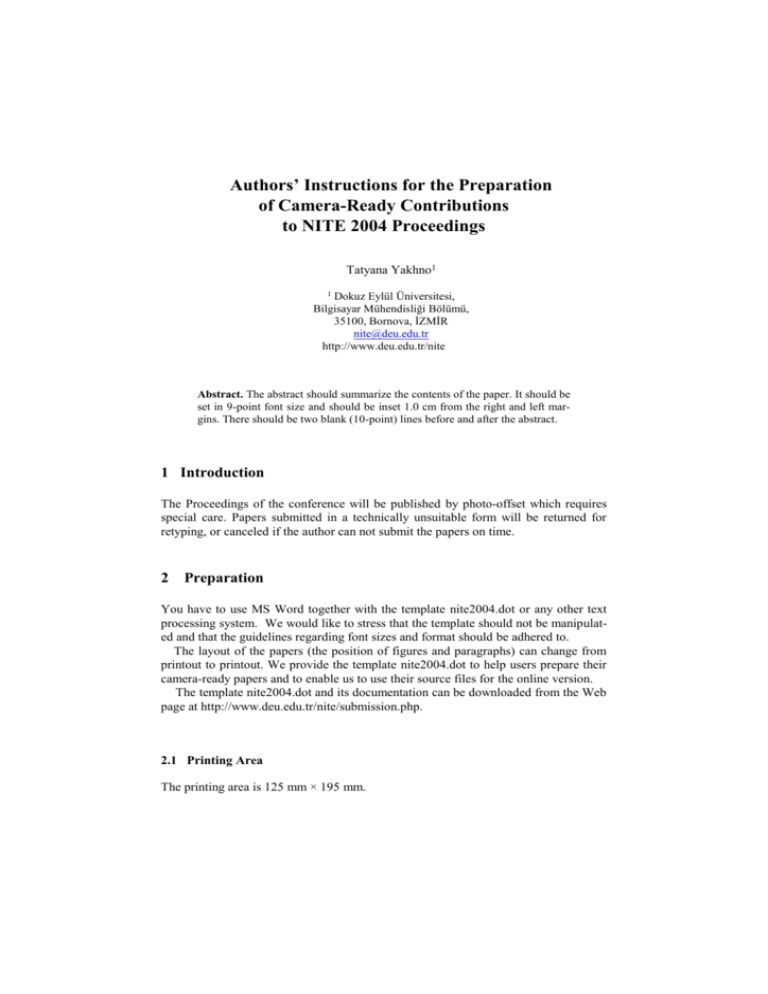
Authors’ Instructions for the Preparation of Camera-Ready Contributions to NITE 2004 Proceedings Tatyana Yakhno1 1 Dokuz Eylül Üniversitesi, Bilgisayar Mühendisliği Bölümü, 35100, Bornova, İZMİR nite@deu.edu.tr http://www.deu.edu.tr/nite Abstract. The abstract should summarize the contents of the paper. It should be set in 9-point font size and should be inset 1.0 cm from the right and left margins. There should be two blank (10-point) lines before and after the abstract. 1 Introduction The Proceedings of the conference will be published by photo-offset which requires special care. Papers submitted in a technically unsuitable form will be returned for retyping, or canceled if the author can not submit the papers on time. 2 Preparation You have to use MS Word together with the template nite2004.dot or any other text processing system. We would like to stress that the template should not be manipulated and that the guidelines regarding font sizes and format should be adhered to. The layout of the papers (the position of figures and paragraphs) can change from printout to printout. We provide the template nite2004.dot to help users prepare their camera-ready papers and to enable us to use their source files for the online version. The template nite2004.dot and its documentation can be downloaded from the Web page at http://www.deu.edu.tr/nite/submission.php. 2.1 Printing Area The printing area is 125 mm × 195 mm. The text should be justified to occupy the full line width, so that the right margin is not ragged, with words hyphenated as appropriate. Please fill pages so that the length of the text is no less than 180 mm. 2.2 Layout, Typeface, Font Sizes, and Numbering Use 10-point type for the name(s) of the author(s) and 9-point type for the address(es) and the abstract. For the main text, please use 10-point type and single-line spacing. We recommend using Times or one of the similar typefaces widely used in phototypesetting. Headings. Headings should be capitalized (i.e., nouns, verbs, and all other words except articles, prepositions, and conjunctions should be set with an initial capital) and should, with the exception of the title, be aligned to the left. The font sizes are given in Table 1. Table 1. Font sizes of headings. Table captions should always be positioned above the tables. The final sentence of a table caption should end without a period Heading level Title (centered) Example 1st-level heading 2nd-level heading 3rd-level heading 4th-level heading 1 Introduction Papers … 2.1 Printing Area Headings. Text follows … Remark. Text follows … Font size and style 14 point, bold 12 point, bold 10 point, bold 10 point, bold 10 point, italic Lemmas, Propositions, and Theorems. The numbers accorded to lemmas, propositions, and theorems etc. should appear in consecutive order, starting with the number 1, and not, for example, with the number 11. 2.3 Figures and Photographs Please produce your figures electronically, if possible, and integrate them into your word file. Check that in line drawings, lines are not interrupted and have constant width. Grids and details within the figures must be clearly readable and may not be written one on top of the other. Line drawings should have a resolution of at least 800 dpi (preferably 1200 dpi). Figures should be numbered and should have a caption which should always be positioned under the figures, in contrast to the caption belonging to a table, which should always appear above the table. The distance between text and figure should be about 8 mm, the distance between figure and caption about 5 mm. If possible please define figures as floating objects. If you have to insert a pagebreak before a figure, please ensure that the previous page is completely filled. To ensure that the reproduction of your illustrations is of reasonable quality we advise against the use of shading. The contrast should be as pronounced as possible. This particularly applies for screenshots. 2.4 Formulas Displayed equations or formulas are centered and set on a separate line (with an extra line or half line space above and below). Displayed expressions should be numbered for reference. The numbers should be consecutive within each section or within the contribution, with numbers enclosed in parentheses and set on the right margin. For example, x+y=z. (1) Please punctuate a displayed equation in the same way as ordinary text but with a small space before the end punctuation. 2.5 Program Code Program listings or program commands in the text are normally set in typewriter font, e.g., Courier. Example: program Inf const MaxYears = 10; var Year: 0..MaxYears; begin end. 2.6 Footnotes The superscript numeral used to refer to a footnote appears in the text either directly after the word to be discussed or – in relation to a phrase or a sentence – following the punctuation sign (comma, semicolon, or period). Footnotes should appear at the bottom of the normal text area, with a line of about 5cm set immediately above them.1 1 The footnote numeral is set flush left and the text follows with the usual word spacing. 2.7 Citations The list of references is headed “References” and is not assigned a number in the decimal system of headings. The list should be set in small print and placed at the end of your paper, in front of the appendix, if one exists. Please do not insert a pagebreak before the list of references if the page is not completely filled. For citations in the text please use square brackets and consecutive numbers: [1], [2], [3]. 2.8 Page Numbering and Running Heads Your paper should show no printed page numbers; these are allocated by the Proceedings editor. Do not set running heads. References 1. Baldonado, M., Chang, C.-C.K., Gravano, L., Paepcke, A.: The Stanford Digital Library Metadata Architecture. Int. J. Digit. Libr. 1 (1997) 108–121 2. Bruce, K.B., Cardelli, L., Pierce, B.C.: Comparing Object Encodings. In: Abadi, M., Ito, T. (eds.): Theoretical Aspects of Computer Software. Lecture Notes in Computer Science, Vol. 1281. Springer-Verlag, Berlin Heidelberg New York (1997) 415–438 3. van Leeuwen, J. (ed.): Computer Science Today. Recent Trends and Developments. Lecture Notes in Computer Science, Vol. 1000. Springer-Verlag, Berlin Heidelberg New York (1995) 4. Michalewicz, Z.: Genetic Algorithms + Data Structures = Evolution Programs. 3rd edition. Springer-Verlag, Berlin Heidelberg New York (1996)
